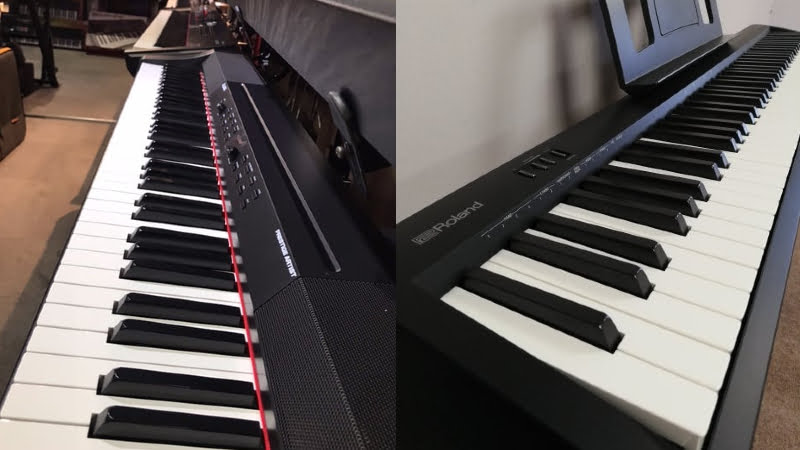I really enjoyed comparing the Alesis Prestige Artist vs the Roland FP-10. Both of these pianos are usually seen as the best beginner’s pianos out there, and they both offer a great set of features that make it easier to learn the instrument.
However, after testing each of the features out and comparing them, I found the Alesis Prestige Artist to be the better overall option. It comes with more voices, better polyphony, a variety of playing modes, additional effects, and just about everything you’ll need when starting out with piano lessons.
The Roland FP-10, on the other hand, came with a decent set of voices, great tone, and a couple of cool extra features. It holds up very well against any piano in its price range, but it simply can’t compete with the Alesis Prestige Artist. In fact, the Alesis model was so good, I would even recommend it to novice and advanced piano students!
Alesis Prestige Artist vs Roland FP-10: Comparison Chart




Last update on 2025-05-08 / Affiliate links / Images from Amazon Product Advertising API
Alesis Prestige Artist vs Roland FP-10: Differences
As I mentioned earlier, the way I declared a winner between the two was by comparing the features head to head. It took a lot of testing, but in the end, the Alesis Prestige Artist won with a score of 3-2. There were some aspects where the FP-10 put up a good fight, but in the end the Alesis Prestige Artist was the superior option by a mile.
Feel
The winner: Roland FP-10
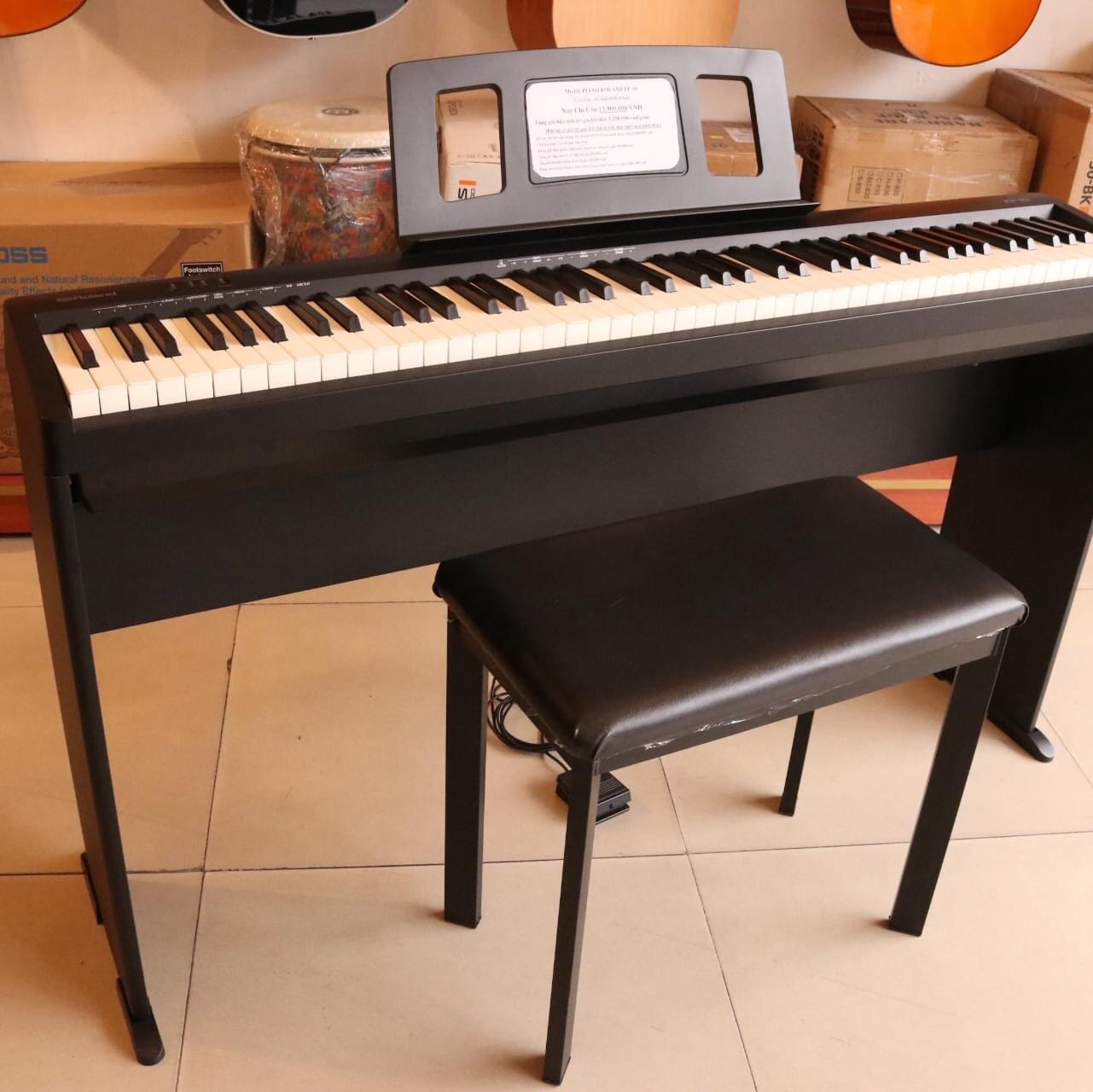
This was the very first feature I compared between the two, and in the end, the Roland FP-10 came out on top because of its better key texture. For two beginner pianos, these instruments offer a very realistic feel that feels very close to standard acoustic pianos. With that said, considering the fact that these are on the more affordable side, they did come with some lapses as well.
+Hammer Action
Both of these pianos have graded hammer action. That means that the lower keys will be heavier and the action gets gradually lighter as you go up the keyboard. This is similar to how acoustic pianos are set up, which gives both instruments a very realistic feel.
While they use different systems, it was hard to tell the difference between the hammer action on the instruments. After careful observation though, I found that the Alesis Prestige Artist had slightly heavier action. Whether this is a good or bad thing largely depends on you, as different pianists have different preferences when it comes to hammer action.
+Key Texture
These two pianos have very similar key textures, but that isn’t necessarily a good thing. Both the Alesis Prestige Artist and the Roland FP-10 have fairly glossy keys, which isn’t exactly a good thing. The Alesis Prestige Artist in particular only features plastic piano keys without any sort of coating to mimic the feel of wooden keys. This isn’t a major flaw, but the more you familiarize yourself with acoustic pianos, the more glaring it becomes.
The one advantage the Roland FP-10 has over the Alesis model is the key texture. While it’s still on the “glossier” side, the FP-10’s keys have an “Ivory Touch” coating. This is meant to mimic the feel of real acoustic piano keys. While the Roland’s keys feel a bit more realistic than the Alesis, it isn’t up to par with some of the more professional models in higher price ranges.
Tone
The winner: Alesis Prestige Artist
If you listen to either of these pianos, you’ll be surprised at how affordable they are. In terms of tone quality, it was very hard to choose a winner between the two since they both have really crisp and clear piano tones. However, I chose the Alesis Prestige Artist as the winner because of its much richer sound library.
+Tone Generation
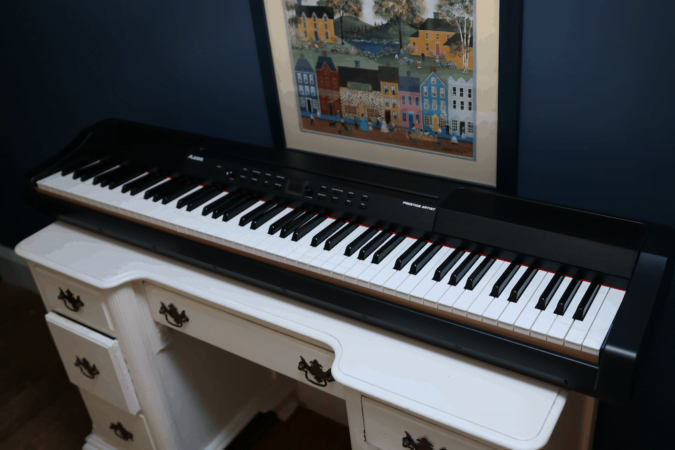
In my experience, it’s hard to compete with the tone generation capabilities of Roland. However, since the FP-10 uses the SuperNATURAL tone engine, a great, but fairly basic Roland tone generator, the multi-sampling technology of Alesis was able to put up a very good fight. The reason these two have a very similar tone is because they use the same basic principle: sampling. However, these two pianos do it in very different ways.
The SuperNATURAL tone engine uses top-quality samples from each of the piano’s 88 keys. The difference, however, is that Roland uses the full sample with natural decay and a digital filter. Most pianos use digital decay to save on space, but Roland doesn’t do that and the result is a very rich and crisp set of piano tones.
The multi-sampling method of Alesis works in a fairly unique way. Instead of playing one sample whenever you press down on a key, the Alesis Prestige Artist plays multiple samples. The result is a more steroized tone with richer and deeper details.
When comparing the tone of these two pianos, I’d say they are a tie. They are much better than just about any regular digital piano that uses traditional samples. However, they still aren’t as good as the robust tone engines on the more expensive models. All in all, a great pick for beginners.
+ Sound Library
The main reason the Alesis Prestige Artist wins in terms of tone is because of its sound library. This model comes with an incredible 30 different voices for pianists to play around with. This includes a wide selection of different piano, electric piano, strings, bass, and synth voices. Whether you’re playing traditional classical music or diving into experimental synthwave, the Alesis Prestige Artist holds a wide range of tones that you can use.
The Roland FP-10 admittedly comes with a fair amount of tones for a digital piano. This piano comes with 12 voices, and while it’s great for its price range, it simply pales in comparison to the Alesis model. You still get a fairly varied selection of voices, but you don’t have as much versatility as the Alesis Prestige Artist.
Piano Features
The winner: Alesis Prestige Artist
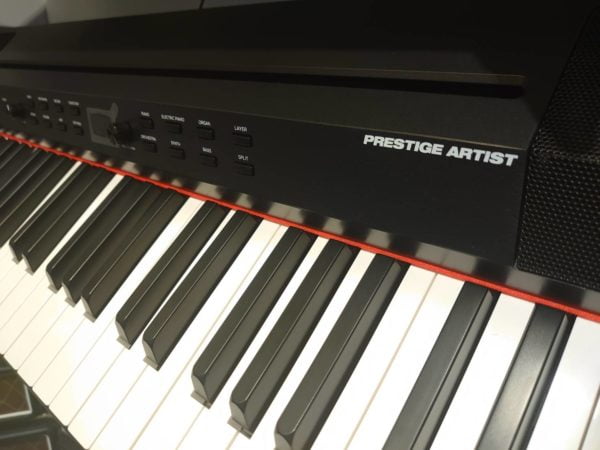
For a beginner’s piano, the Roland FP-10 comes with a fairly significant set of features. However, since the Alesis Prestige Artist has better effects, more playing modes, and better overall polyphony, it was the clear winner.
+Playing Modes
The Alesis Prestige Artist comes with three different playing modes: lesson, split, and layer. These all have their own uses and are incredibly practical features for beginners and novices alike. With lesson mode, you can divide the piano into two smaller, twin pianos with the same tuning. This is mostly used during piano lessons as it allows two people to play a duet or demonstrate different techniques to each other without crossing over.
Split mode divides the piano into two keyboards with different voices. This has a lot of practical applications, especially for performers. For example, you can load a bass voice on the left side and a piano or synth voice on the upper end. This allows you to give off the illusion of playing two instruments at once, with one instrument playing the rhythm section and other playing the melody section.
Lastly, layer mode blends two different voices. You can blend strings and piano, synth and bass, and just about any two voices on the Alesis Prestige Artist. This gives pianists a lot of room for experimentation, finding a lot of unique combinations in the process.
On top of that, you can even record on the Alesis Prestige Artist, making it a complete workhorse with a lot of different uses.
The Roland FP-10, on the other hand, only comes with lesson and layer mode. This piano doesn’t have a record or split function, which is one of the main reasons the Alesis Prestige Artist is the easy choice for most pianists.
+ Effects
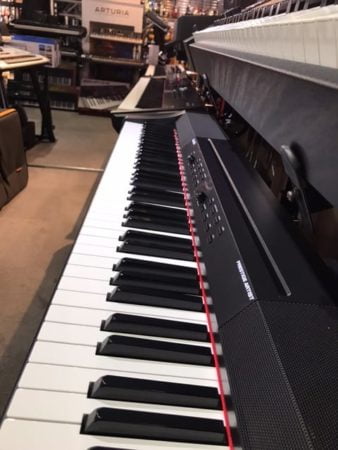
The Roland FP-10 allows you to control the ambience and brilliance of your tone. This is about all the effects you have on the FP-10, and it’s only really used by experienced pianists. Ambience and brilliance are very subtle qualities of a piano’s tone, and it will take a lot of practice to figure out how to use them to your advantage.
While the Prestige Artist doesn’t have ambience and brilliance control, it does have a selection of different reverbs. For most pianists, reverb is a much more practical effect to have. It allows you to add a lot of depth and body to your tone, which is why I found the effects on the Alesis Prestige Artist much better than the ones on the Roland FP-10.
+ Polyphony
Polyphony is another area where the Alesis Prestige Artist was the clear winner. This piano has a maximum polyphony of 256 notes, which is about as good as it gets in this price range. However, keep in mind that this isn’t true 256-note polyphony, as each voice plays multiple samples per note. So, the polyphony of this piano is closer to 128, which is still much better than the Roland FP-10.
Since the Roland only plays one sample per note, it doesn’t require that much polyphony. However, 96-note maximum polyphony is still a slight let-down. You won’t run into trouble when playing basic beginner piano pieces, but once you start playing wider and spread out chords with the sustain pedal, you’ll start to hear where the piano is lacking.
Connectivity & App Integration
The winner: Roland FP-10
This is one of the rare areas where I found the Roland FP-10 to be the clear winner. And the main reason for this is that it comes with BlueTooth connectivity. You can connect the piano to your phone or mobile device and access a bunch of different learning apps to help you throughout your piano journey.
On top of that, you also have USB MIDI connectivity. That means you can use it as a MIDI controller for virtual instruments on your computer and even use it for different piano lesson apps.
The Alesis Prestige Artist only features USB connectivity. This is more than enough, especially considering the fact that this piano comes with a bunch of different subscriptions for premium online and digital piano lessons. However, it still would have been nice for the Alesis model to feature BlueTooth connectivity.
Sound System
The winner: Alesis Prestige Artist
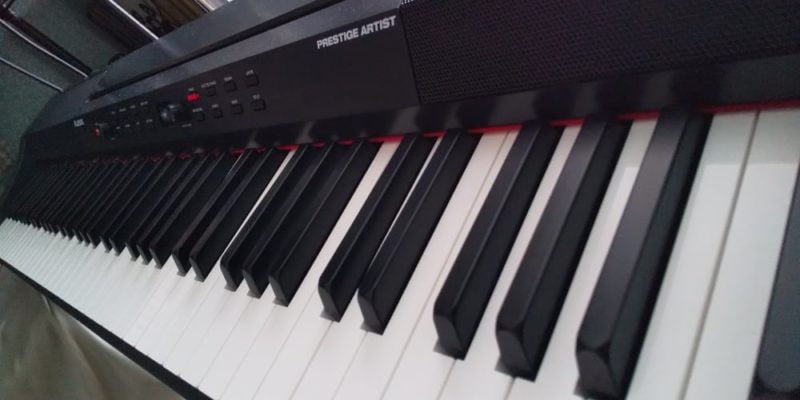
Both pianos come with fairly basic sound systems. However, the Alesis Prestige Artist has more sophisticated speakers and a wider range of additional outputs, which is why it easily beat out the Roland FP-10 in this comparison.
+ Speakers
The Alesis Prestige Artist comes with two built-in speakers, each with a woofer and passive radiator. On the other hand, the Roland FP-10 only comes with two built-in 6W speakers. Neither of these pianos give off particularly loud tones, but I noticed the sound quality of the Alesis Prestige Artist is slightly better than the Roland FP-10.
+ Additional Inputs & Outputs
Another area where the Alesis is the clear winner is with its additional inputs and outputs. On the back of the keyboard, you have separate inputs for headphones and speakers. This is great for performing and practicing in private and gives pianists a wide range of options when it comes to connecting to external sound systems.
The Roland FP-10 only features one additional output. This is still useful as it allows you to connect to another sound system if you need additional volume, but it just isn’t as versatile as the Alesis model.
Alesis Prestige Artist vs Roland FP-10: The Similarities
Since these are both entry-level digital pianos, there are some similarities between the two. They both have graded hammer action, have a full-keyboard, and provide great accurate piano tones. If you’re a beginner looking for your first digital piano, either of these options would work incredibly well.
However, the Alesis Prestige Artists does have features that will last you a longer time. This is why it’s the better option since it can still work great when your skill level goes up. Both pianos also have USB MIDI connectivity options, which is a great feature for any digital piano.
But that’s really where the similarities end. These are two very different instruments, which is why it was such a joy writing this comparison.
Quick Rundown of the Alesis Prestige Artist
- It’s Time to Upgrade your Electric Piano – 88 key piano keyboard with graded hammer action and adjustable touch response for a natural piano feel - for beginner, intermediate and advanced players
- Packed with Premium Sounds - 30 multi-sampled voices including Grand Piano, Electric Piano, Organ, Synthesizers & more; simultaneous Split & Layer modes; built-in arpeggiator; 5 adjustable Reverb FX
- Authentic Playing Experience - 256 max polyphony provides a superb 88 key piano playing experience; 50W micro-array speaker system sounds loud, clear and realistic in any setting
- Stage Piano Essentials – OLED screen for intuitive control; Stereo 1/4” outputs; 1/4” and 1/8” (3.5mm) headphone outputs; USB-MIDI output for use with educational software or virtual
- The Complete Full Size Keyboard Piano Experience - Piano style sustain pedal, music rest, and power adapter included; Lesson & Record Modes to develop your electric keyboard piano skills
Last update on 2025-05-08 / Affiliate links / Images from Amazon Product Advertising API
Quick Rundown of the Roland FP10
- Rich, responsive tone from Roland renowned supernatural piano sound engine
- 88-Key hammer-action with progressively weighted piano touch for maximum expression
- Bluetooth MIDI for wireless connection to popular apps for Education, creativity, and enjoyment on your mobile device
- Roland free piano Partner 2 app provides remote control and added functionality for the FP-10
- Usb MIDI for one-cable connection to computers or mobile devices
Last update on 2025-05-08 / Affiliate links / Images from Amazon Product Advertising API
Product Video
Related Articles to Alesis Prestige Artist
- Alesis Prestige Artist vs Korg B2: The Better $500 Digital Piano
- Alesis Prestige Artist vs Recital Pro: Which Is the Best Alesis Piano for Beginners?
- Alesis Prestige Artist vs Yamaha P125 Comparison: Why the Yamaha P125 Is the Better Investment
- Alesis Prestige Artist vs Yamaha P45: Can Alesis Hold Its Own Against the Popular Yamaha Model?
- Alesis Prestige vs Prestige Artist: Can the Alesis Prestige Hold Its Own Against the Upgraded Prestige Artist?
References:
- Roland FP-10 Digital Piano: https://www.sweetwater.com/store/detail/FP10BK–roland-fp-10-black
- Alesis Prestige Artist 88-key Digital Piano w/ Graded Hammer Action Keys: https://www.sweetwater.com/store/detail/PrestigeArt–alesis-prestige-artist-88-key-digital-piano-with-graded-hammer-action-keys
Lulacruza is an electronic folk duo operating at the junction of the hypermodern and the ancient. Our music weaves together hypnotic female singing, South American folk instruments and electronic processing, while channeling pulsating waves from the source of creation.
Lalucruza is also a community where you can connect with other music lovers to collaborate, exchange ideas and share knowledge. A platform for who wants to learns the basics of playing piano, guitar, drum masters’ technique, etc.. is the premise of our website.
